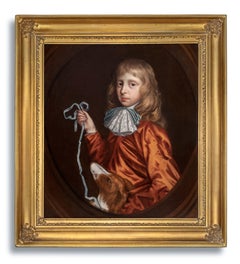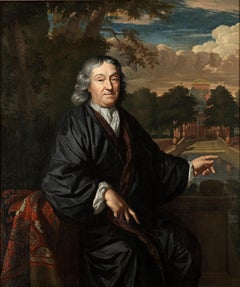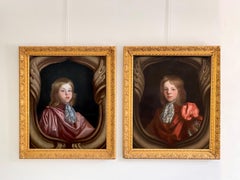18th Century and Earlier Portrait Paintings
to
2
2
1
1
Overall Height
to
Overall Width
to
1
1
1
1
1
2
2
6
6
4
3
2
2
2
2
Period: 18th Century and Earlier
Artist: (Circle of) Mary Beale
Portrait of a Gentleman
Located in London, GB
Circle of Mary Beale
1633 - 1699
Portrait of a Gentleman
Oil on canvas
Image size: 30 x 25 inches
Contemporary gilt frame
Mary Beale was the daughter of a Suffolk clergyman.She married Charles Beale...
Category
18th Century and Earlier Portrait Paintings
Materials
Oil, Canvas
Portrait of a Young Gentleman and Pet Dog c.1680, Antique oil on Canvas Painting
Located in London, GB
The portrait genre was valued particularly highly in English society. Neither landscapes nor allegorical pictures were ever priced so highly at exhibitions and in the trade as depictions of people, from the highest aristocracy to scholars, writers, poets and statesmen. This charming portrait, presented by Titan Fine Art, of a fashionable young gentleman and his faithful pet is an excellent example of 17th century child portraiture in England. There is a remarkable beauty and sensitivity to the portrait. The face, particularly well rendered, has captured the character of this young man – both charming and at the same time mischievous.
Only the playful attention of a small dog suggests anything less than patrician dignity. Symbolism was important in portraiture and it provided a pointed and aspirational narrative that would not have been lost on contemporary viewers. For example, the presence of the dog, which was likely the boy’s pet, is at once a charming pictorial device and also a clear allusion to fidelity, trust and loyalty.
The hairstyle and the attire, notably the type of cravat with the blue ribbon, help to date this portrait to between 1670 to 1685. Until the late eighteenth century children were dressed as adults - boys were dressed like men in breeches, vests, and coats between four and seven years of age. The expensive lace is an indication to his family’s wealth.
Held in a good quality and condition antique gilded frame.
Born in Suffolk, Mary Beale, nee Cradock (1633-1699) was employed by many of the most distinguished persons of her time including nobility, landed gentry, and clergymen. Technically accomplished, her paintings are noteworthy for their honest and sympathetic portrayal. In 1651 she married Charles Beale...
Category
Old Masters 18th Century and Earlier Portrait Paintings
Materials
Canvas, Oil
Related Items
Young woman portrait with a white bow
Located in BELEYMAS, FR
Charles HERMANN-LÉON (born Léon Charles Sigismond HEMRMANN)
(Le Havre 1838 - Paris 1908)
Portrait of a young woman
Oil on canvas
H. 54 cm; L. 41 cm
Signed and dated upper right - 187...
Category
French School 18th Century and Earlier Portrait Paintings
Materials
Oil, Canvas
Male and female portrait, both in silk kimono, possibly textile dealers
By Christoffel Lubieniecki
Located in Amsterdam, NL
CHRISTOFFEL LUBIENIECKI (1659-1729)
Pair of portraits of a gentleman and a lady, both in silk kimono, before a country house (circa 1680)
Indistinctly signed “C.......” on a box under the man’s left hand
Oil on canvas, 79.5 x 67 cm each
Both sitters are portrayed wearing a silk “Japanese” coat. During the second half of the seventeenth the Japanese silk coat, an adapted Japanese kimono, became a real vogue in the Dutch elite. The exclusive Dutch trade contacts with Japan can explain the popularity of the kimono-style silk coats in the Netherlands. Everybody who could afford one, dressed in such a fashionable and comfortable coat and, like the present sitters, some proud owners had themselves portrayed in a “Japanese” coat often together with an oriental carpet to underline their standing and international connections. These portraits are the work of the Polish-born portraitist Christoffel Lubieniecki (also known as Lubienitski, Lubinitski or Lubiniecki)
Lubieniecki was first trained in Hamburg under Julian Stuhr and after 1675 in Amsterdam under Adriaen Backer and Gerard de Lairesse. He specialized in landscapes, generally of an Italianate character, and in portraits. The loving execution of these contented burghers, enjoying the garden vistas of their country house, places him alongside Amsterdam portraitists such as Constantijn Netscher and Michiel van Musscher...
Category
Old Masters 18th Century and Earlier Portrait Paintings
Materials
Canvas, Oil
Free Shipping
H 31.34 in W 26.38 in D 1.97 in
17th Century portrait oil painting of a gentleman
By John Riley
Located in Moreton-In-Marsh, Gloucestershire
Circle of John Riley
British, (1646-1691)
Portrait of a Gentleman
Oil on canvas
Image size: 29 inches x 24 inches
Size including frame: 36 inches x 31 inch...
Category
Old Masters 18th Century and Earlier Portrait Paintings
Materials
Canvas, Oil
Portrait of singer Adelina Patti - L. Frossard - Opera
Located in BELEYMAS, FR
L. FROSSARD
(active in Vienna around 1870)
Portrait of Adelina Patti (1843-1919)
Oil on canvas
H. 100.5 cm; L. 73.5 c
Signed lower left
If the artist maintains a certain discretion ...
Category
French School 18th Century and Earlier Portrait Paintings
Materials
Canvas, Oil
17th Century portrait oil painting of a Lady
By Michael Dahl
Located in Moreton-In-Marsh, Gloucestershire
Circle of Michael Dahl
Swedish, (1659-1743)
Portrait of a Lady
Oil on canvas
Image size: 29 inches x 24 inches
Size including frame: 36 inches x 31 inches
A fine half-length portra...
Category
Old Masters 18th Century and Earlier Portrait Paintings
Materials
Canvas, Oil
Contemporary Fabulous Portrait of The Queen with Detailed Royal Crown/Jewels
By Nancy Lamb
Located in Fort Worth, TX
Nancy Lamb (American, born 1956), sculptor and painter. Formally trained at Texas Christian University and the Fort Worth Museum of Science and History, whe...
Category
American Realist 18th Century and Earlier Portrait Paintings
Materials
Canvas, Acrylic, Oil
H 38 in W 57 in D 2.5 in
French School, Portrait of a Young Lady, Actress, Louis XIV sculpted frame, 1700
Located in Greven, DE
French School,
Portrait of a Young Lady, perhaps an actress
Oval
Louis XIV sculpted and gilded frame
French Art, Roccoco Art
The oval portrait of a young woman measures 61 by 50,5 cm canvas sight size and its 18th century oak carved and gilded frame...
Category
Rococo 18th Century and Earlier Portrait Paintings
Materials
Canvas, Oil
Two royal portraits (the Duc d'Angoulême and the Duc de Berry) by H.P. Danloux
Located in PARIS, FR
These two royal portraits are a major historical testimony to the stay of the Comte d'Artois (the future Charles X) and his family in Edinburgh in 1796-1797. Given by the sitters to Lord Adam Gordon, the Governor of Edinburgh, and kept by family descent to this day, these two portraits provide us with a vivid and spontaneous image of the Duc d’Angoulême and his brother the Duc de Berry. Danloux, who had emigrated to London a few years before, demonstrate his full assimilation of the art of British portrait painters in the brilliant execution of these portraits.
1. Henri-Pierre Danloux, a portraitist in the revolutionary turmoil
Born in Paris in 1753, Henri-Pierre Danloux was first a pupil of the painter Nicolas-Bernard Lépicié (1735 - 1784) and then, in 1773, of Joseph-Marie Vien (1716 - 1809), whom he followed to Rome when, at the end of 1775, Vien became Director of the Académie de France. In Rome he became friends with the painter Jacques-Louis David (1748 - 1825).
Returning to France around 1782, he settled in Lyon for a few years before returning to Paris in 1785. One of his first portraits was commissioned by the Baroness d'Etigny, the widow of the former Intendant of the Provinces of Gascony, Bearn and Navarre Antoine Mégret d'Etigny (1719 – 1767). He then became close to his two sons, Mégret de Sérilly and Mégret d'Etigny, who in turn became his patrons. In 1787, this close relationship with the d'Etigny family was further strengthened by his marriage to Antoinette de Saint-Redan, a relative of Madame d'Etigny. After his marriage, he left for Rome and did not return to France until 1789. It was during the winter of 1790-1791 that he painted one of his masterpieces, the portrait of Baron de Besenval. Set in a twilight atmosphere, this portrait of an aristocrat who knows that his death is imminent symbolizes the disappearance of an erudite and refined society which would be swept away by the French Revolution.
The Jacobin excesses led Danloux to emigrate to England in 1792; many members of his family-in-law who remained in France were guillotined on 10 May 1794. Danloux enjoyed great success as a portrait painter in England before returning to France in 1801.
During his stay in England, Danloux was deeply under the influence of English portraitists: his colors became warmer (as shown by the portrait of the Duc d'Angoulême that we are presenting), and his execution broader.
2. Description of the two portraits and biographical details of the sitters
The Duc d'Angoulême (1775-1844) was the eldest son of the Comte d'Artois, the younger brother of King Louis XVI (the future King Charles X), and his wife Marie-Thérèse of Savoie. He is shown here, in the freshness of his youth, wearing the uniform of colonel-general of the "Angoulême-Dragons" regiment.
He is wearing the blue cordon of the Order of the Holy Spirit, which was awarded to him in 1787, and two decorations: the Cross of Saint-Louis and the Maltese Cross, as he was also Grand Prior of the Order of Malta.
Born on 16 August 1775 in Versailles, Louis-Antoine d'Artois followed his parents into emigration on 16 July 1789. In 1792, he joined the émigrés’ army led by the Prince de Condé. After his stay in Edinburgh (which will be further discussed), he went to the court of the future King Louis XVIII, who was in exile at the time, and in 1799 married his first cousin Marie-Thérèse Charlotte of France, the daughter of Louis XVI and the sole survivor of the royal family. The couple had no descendants. He became Dauphin of France in 1824, upon the accession to the throne of his father but played only a minor political role, preferring his military position as Grand Admiral. Enlisted in Spain on the side of Ferdinand VII, he returned home crowned with glory after his victory at Trocadero in 1823.
He reigned for a very short time at the abdication of Charles X in 1830, before relinquishing his rights in favor of his nephew Henri d'Artois, the Duc de Bordeaux. He then followed his father into exile and died on 3 June 1844 in Gorizia (now in Italy).
His younger brother, the Duc de Berry, is shown in the uniform of the noble cavalry of the émigrés’ Army. He is wearing the blue cordon of the Order of the Holy Spirit, awarded to him in May 1789, and the Cross of Saint-Louis (partly hidden by his blue cordon).
Born on 24 January 1778 in Versailles, Charles-Ferdinand d'Artois also followed his parents into emigration and joined the émigrés’ army in 1792. After his stay in Edinburgh, he remained in Great Britain, where he had an affair with Amy Brown...
Category
Old Masters 18th Century and Earlier Portrait Paintings
Materials
Canvas, Oil, Wood Panel
17th Century portrait oil painting of a lady
Located in Moreton-In-Marsh, Gloucestershire
Circle of Sir Peter Lely
Dutch, (1618-1680)
Portrait of a Lady, traditionally identified as Princess Henrietta Anne Stuart
Oil on canvas
Image...
Category
Old Masters 18th Century and Earlier Portrait Paintings
Materials
Canvas, Oil
H 37 in W 32.5 in D 2.5 in
Woman with Lobsters / "Femme et Homards"
By Andre Minaux
Located in Berlin, MD
Andre Minaux (French 1923 - 1986) "Femme et Homards" / Woman with Lobsters. Oil on canvas. Features a young woman holding one lobster while two others sit on a counter before her. ...
Category
French School 18th Century and Earlier Portrait Paintings
Materials
Cotton Canvas, Oil
18th Century portrait oil painting of a lady in an ermine trimmed cloak
Located in Moreton-In-Marsh, Gloucestershire
Circle of Sir Godfrey Kneller
Dutch, (1646-1723)
Portrait of a Lady in an Ermine Trimmed Cloak
Oil on canvas
Image size: 26.5 inches x 22.5 inches
Size including frame: 33.5 inches x 29.5 inches
A well-executed half-length portrait of a lady painted in a feigned oval, circle of Sir Godfrey Kneller. The use of a feigned oval was a device used in portraiture to give a sense of depth and add an intimacy to the painting, drawing your attention to the sitter.
The subject, posed without her wig in the undressed fashion of the day, wears a blue ermine trimmed blue cloak over a white silk robe...
Category
Old Masters 18th Century and Earlier Portrait Paintings
Materials
Canvas, Oil
H 33.5 in W 29.5 in D 2.25 in
Elisabeth Dujarric de la Rivière (1930-2005) Self-portrait with palette
Located in BELEYMAS, FR
Elisabeth DUJARRIC de LA RIVIÈRE
(Jouy-en-Josas 1930 - Excideuil 2005)
Self-portrait with apple
Oil on canvas
H. 100 cm ; L. 73 cm
Sig...
Category
Cubist 18th Century and Earlier Portrait Paintings
Materials
Canvas, Oil
Previously Available Items
Pair of 17th century British Portraits of the brothers Baronet Stapleton English
Located in Antwerp, BE
Pair of 17th century British Portraits, James and William Stapleton, 2nd and 3rd Baronet Stapleton of the Leeward Islands, at the ages of 11 and 8, ca ...
Category
Old Masters 18th Century and Earlier Portrait Paintings
Materials
Oil, Canvas
Portrait of a Young Lady in a Russet Dress with Blue Wrap c.1680’s; Mary Beale
Located in London, GB
Portrait of a Young Lady in a Russet Dress with Blue Wrap c.1680’s
Circle or Studio of Mary Beale (1632-1699)
This exquisite portrait is a charming example of English portraiture from the 1680’s. It depicts a young woman at the tender age of perhaps fifteen; she would have been deemed ready for marriage. It is remarkable for its sensitivity, its beauty, and for its portrayal of the sitter’s amiable and friendly character. An elaborate sculpted cartouche used in portraits, as seen here, was employed by many artists in England at the time, but most frequently by Sir Peter Lely and Mary Beale, the most important woman artist to work in England in the second half of the seventeenth century.
The portrait genre was valued particularly highly in English society. Neither landscapes nor allegorical pictures were ever priced so highly at exhibitions and in the trade as depictions of people, from the highest aristocracy to scholars, writers, poets and statesmen. Traditionally the portrait has been attributed to Mary Beale; this attribution is certainly possible.
A charming example of English portraiture during the reign of Charles II. Contained in a fine quality gilded antique frame.
Born in Suffolk, Mary Beale, nee Cradock (1633-1699) was employed by many of the most distinguished persons of her time including nobility, landed gentry, and clergymen. Technically accomplished, her paintings are noteworthy for their honest and sympathetic portrayal. In 1651 she married Charles Beale, who shared her interest in art, and thus the Beale studio was a partnership between husband and wife. While Mary painted, Charles provided practical support. He primed canvases, procured art supplies from merchants, manufactured expensive, high-end pigments such as red lake and ultramarine (some for sale to other painters), and kept the books. He also left detailed notebooks about his wife’s daily activities; such as her commissioned portraits as well as the experimental studies. For the latter, he identifies the sitters and, in most cases, their poses and tracks the progress of each work from one sitting to the next, paying particular attention if a novel technique had been used. The Beale's purpose in carrying out the studies, as well as to develop skills, was to test out, various painting methods. Together they sought to improve the studio's efficiency, through perfecting procedures that would produce good results at a lower cost. These accounts of the daily activities are an incredibly valuable insight into the working practices of her studio. In fact, we know more of her technique and working practice than that of many of her contemporaries, including Sir Peter Lely.
By the late 1650s, Beale had developed a formidable reputation and befriended Sir Peter Lely, the leading artist of the Restoration and court painter to Charles II, King of England. She observed Lely in his studio—a rare privilege—and copied many of his portraits, modelling her technique after his. Lely would visit the Beale home occasionally to observe Mary paint and praise her work and Lely loaned Beale some of his old master paintings to copy from.
During her childhood in Suffolk Mary's father was friendly with contemporary British artists such as Sir Nathaniel Bacon, Robert Walker, and Sir Peter Lely, leading to both Robert Walker and Peter Lely being "the most likely drawing masters to the young Mary". Even though Beale occasionally adapted some of Lely’s poses it is not known for certain with whom she studied; Lely encouraged her in her efforts but there is no evidence that he actually instructed her. However, her father was an amateur artist and seems the most likely candidate to have shown her how to draw and paint.
She was exceedingly industrious and experimented with many new materials and techniques. She often employed the use of an elaborate stone cartouche...
Category
Old Masters 18th Century and Earlier Portrait Paintings
Materials
Oil, Canvas
H 37.21 in W 32.29 in D 2.37 in
Recently Viewed
View AllMore Ways To Browse
Reconstructed Vintage Jewelry
Queen Elizabeth 11 Painting
Tudor Style Paintings
Duchess Of Marlborough
Swiss Painter Lac Leman
Lord Leighton
Mary Richardson
Durham Castle
Fishers Of Men
Gay Boy
Eyitayo Alagbe
Oval Female Portrait Painting
William Frith
Hyacinthe Rigaud
Italian Food Posters
Greek Russian Icon
Holy Roman Emperor
Set Of Carousel Horses




